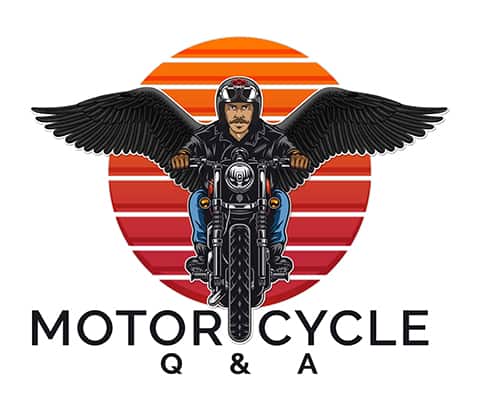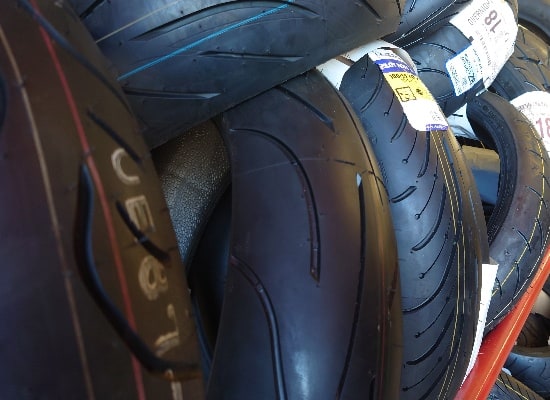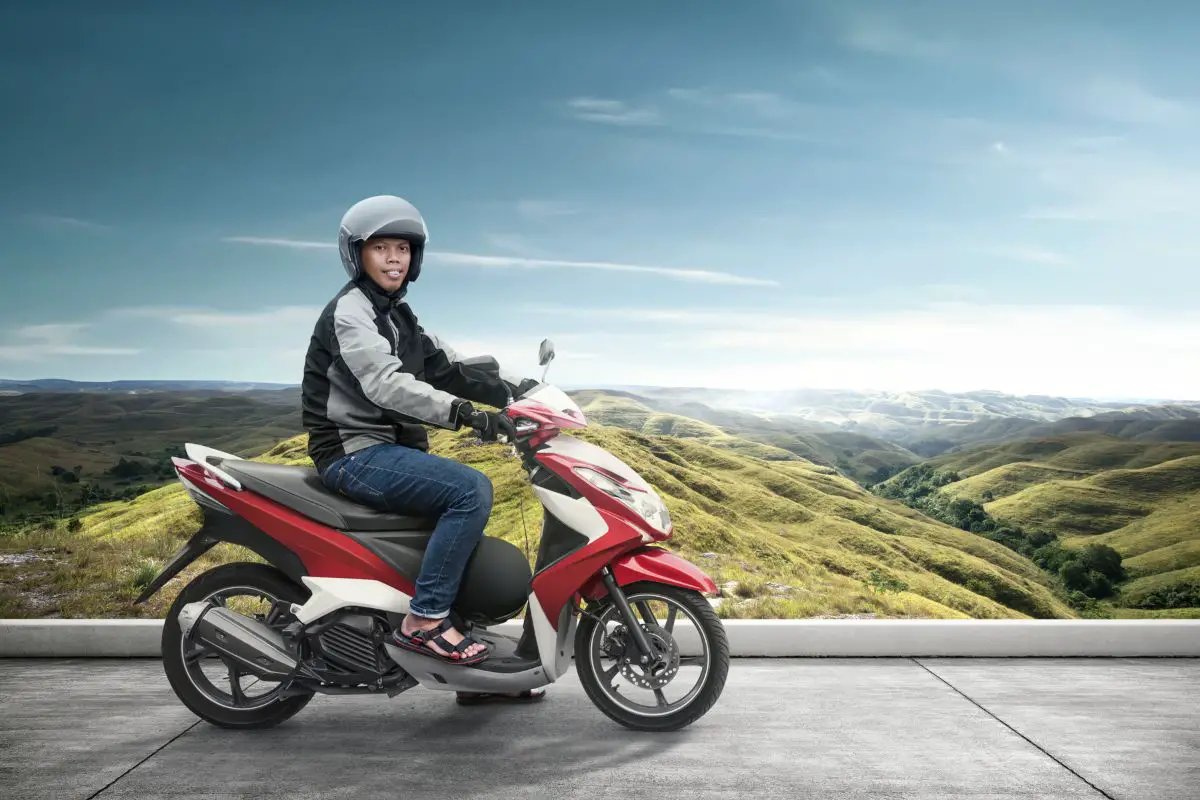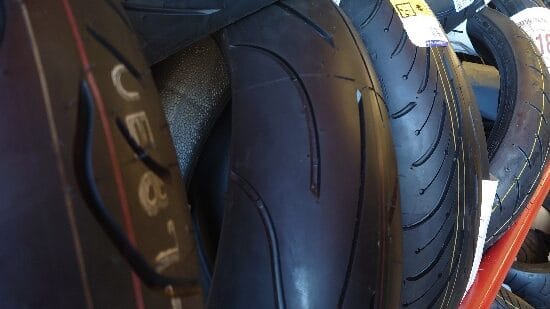
I ride my motorcycle every day and clock up some quite serious mileage on it. When I purchased it about 6 months ago, the stock tires looked quite shinny, but due to the fact I have purchased quite a few new motorcycles over the past 20 years or so, I knew that after taking the bike for a good ride for about 100 miles or so the shine will have disappeared.
Why are new motorcycle tires slippery?
During the manufacturing process of a motorcycle tire, certain chemicals are added during the curing process, making sure the rubber flows smoothly. This helps to reduce any possible defects within the tread pattern and the tire’s surface. The result of this process causes a slippery and shiny surface. This process is the same for car tires as well.
Within this article, I will discuss why new motorcycle tires are shinny in the first place and the correct and safe way to take the shine off the tire.
I want to thank the sponsors of this post-EMANUALONLINE. Using their service, you can download your motorcycle or car manual to your mobile phone or any other device, so you will have it handy should you ever be out and about and need to use it. You can visit their website by clicking the icon below and using the code BUDDY15 to get a 15% discount.
Now we know why motorcycle tires look shinny and are slippery when new, so what is the safest way to get rid of the slippery shine?
I’m going to get straight to the point here and tell you how I make the shine disappear.
Heat.
The best way to make all the lovely shiny, slippery finish disappear is to heat up the tire, and the best and safest way of doing this is to take the motorcycle out for a good ride.
When you take the bike out for a long-distance ride on a freeway doing freeway speeds, the tire warms up. You don’t need to weave the bike left to right going down the road like a Grand Prix racer, make good progress along the road in a straight line, and this will be all it takes.
Depending on the weather conditions, manufacturers recommend that a ride of approximately 180KM or so, give or take 20KM. Make sure that you have a bit of fun whilst your out de-shinning the tire. Accelerating and braking heat up the whole tire, but do this with care.
Don’t start leaning the motorcycle over until you have checked that the tires have heated up. You can do this by stopping for a minute or so and checking the temperature by touching them with your hand. Once they feel warm, you can start leaning the bike and increasing the acceleration and breaking.
So there you go! You’ve been out for a good ride and broken in your new tires.
Don’t forget to carry out this process every time you have a new tire fitted to your motorcycle.
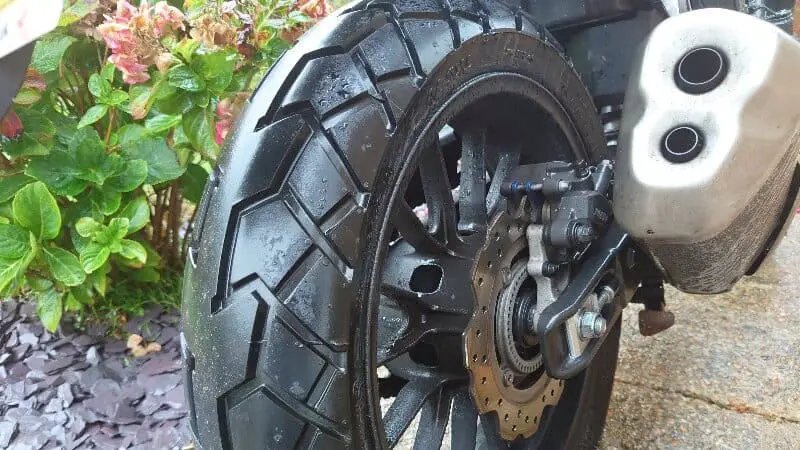
What Is A Motorcycle Tire Made From?
Many of us don’t realize that a tire for our motorcycles, which has been produced to allow us to enjoy our days out or commutes to work, has been produced through a very complex manufacturing process. I have used a Continental tire as an example.
So, what is a motorcycle tire made from?
- Approx 40% Natural and Synthetic Rubber
- Steel
- Polyester
- Rayon
- Nylon
- Carbon
- Gypsum
- Plasticizers
- Sulfur
- Zinc Oxide
- Other Chemicals (Approx 2%)
There are five parts to constructing the tire:
- Firstly the Tread is Constructed
- The Bead Is Constructed
- Carcass Layers are Constructed
- The Carcass Belt is Constructed
- The Sidewall is constructed
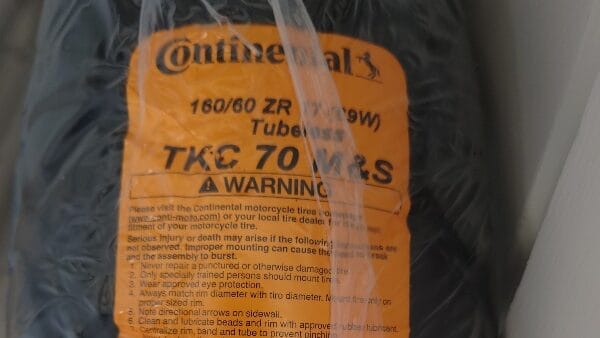
I found an article on CycleNews where they visited the Continental Tire manufacturing plant in Conti Moto in Hanover, Germany. They were shown how the different parts of a tire are made and then assembled. Click here to be taken to this fascinating article.
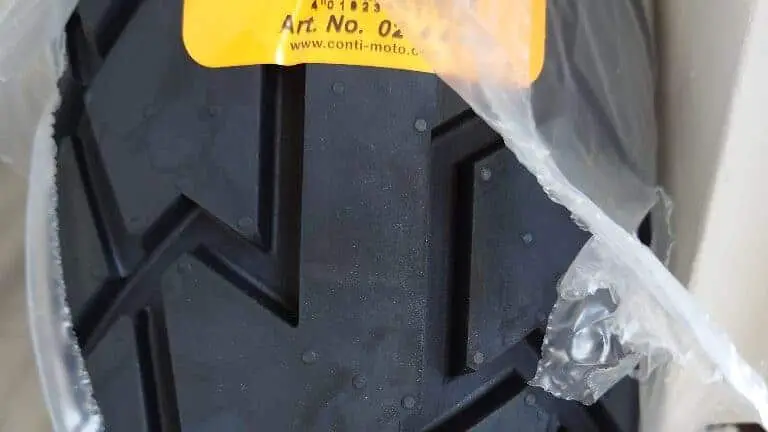
It was very slippery when I unpacked it.
What Are The Different Categories Of Motorcycle Tires? An Interesting Guide.
- Cruiser Tires
- Hyper-sport Tires
- DOT Race Tires
- Sport-Touring Tires
- Road Race Slicks
Cruiser Tires
These tires are extremely stiff and thick as they are made for big heavy motorcycles such as Harley Davidson, Indians Motorcycles, Victory and Custom motorcycles.
These large thick tires perform fantastically in all weather conditions and are built to cover substantial miles on the road.
These tires are manufactured using a harder rubber compound than any other type of motorcycle tire and have many more tread grooves to displace water.
Cruiser tires have outstanding straight-line durability, but the downside is that they have low performance, and the grip is not made to take corners at speed. However, these are made for the large cruisers, performance, and taking corners at speed really don’t come into it anyway!
Hyper-Sport Tires
Need a tire that has great performance on normal roads and also have good performance on track days out? Then these tires are for you!
These offer the rider more speed, traction, and agility than sport touring tires and are similar to DOT tires but with more tread grooves.
These types of tires can be found as stock tires on the sports bikes, which can be in your local dealers as they are classed as premium street tires. There is a downside to these tires: although they are made of dual-compound material, they are not so good in the wet, and you will not get as many miles out of them as you would sport-touring tires.
DOT Race Tires
These tires are similar to slick tires, the difference being they have a tread cut into them to meet the Department Of Transport standards. They also conform to production racing rules as well.
These particular types of tires have to be hot to grip well and will only work well in the dry, so any rainy track days will be out of the question.
DOT Race Tires as the name suggests are constructed specifically for racing.
Sport-Touring Tires
Sport-touring tires are manufactured for great performance and durability. They make a fantastic everyday tire for street sports bikes and have many tread grooves, which extend to the center of the tire. This, in turn, helps disperse water on rainy days.
Usually, these types of tire’s shoulders are made slick, so offer excellent grip when the bike is lent over.
Some are dual compound tires, which means they have a harder rubber compound in the center of the tire, which gives optimum wear and a softer rubber on the tire’s shoulder for the extra grip whilst cornering.
The compound of these types of tire is manufactured to work across a wide range of temperatures, and silicon is usually added to the rubber, which enhances the grip when the roads are wet.
Sport-Touring Tires are designed to work well in all weather conditions when it’s raining and cold or dry and hot, and another benefit is the mileage you can get out of these tires is exceptional!
Road-Race Slicks
Road-Race Tires are at the very top of the performance spectrum. They are extremely expensive and have to meet specific criteria.
These race tires will only last for a short time and are very sensitive to tire pressure and temperature.
Tire warmers to warm them up to nearly 200 degrees need to be used before they can be let loose on the track, which is the only place they can be used for.
Theses fantastic race tires defiantly cannot be used on the road!
What Do The Letters And Numbers On The Side Of A Motorcycle Tire Mean? A Helpful Guide
If you have ever thought about the meaning of all the letters and numbers on the side wall of your motorcycle tire. i’m now going to explain it to you so you will wonder no more!
So, what do the letters and numbers on the side of a motorcycle tire mean? These numbers are significant and indicate the Width, Aspect Ratio, Construction, Rim Diameter, Load Index, and Speed Rating. Any new tire must match each of these numbers correctly.
The Width Of The Tire:
The width of the tier is measured in millimeters, and the measurement is taken from the center of one side of the sidewall to the other center or midpoint mark of the other side of the sidewall. This means that you measure the maximum overall width when looking down onto the tire and not just the part with the tread on it.
The Aspect Ratio:
This is also known as the tires profile and is the height of the tires sidewall. This measurement is shown as a percentage of the tires section width.
Construction:
The construction is referring to the carcass construction. The most common type being the letter ‘R,’ which stands for Radial, which is the most common type of tire construction.
Rim Diameter:
The Rim Diameter is measured in inches and is the wheel’s size the tire will be fitted to. To get the measurement for this, you start at the wheel’s flange where the tire is seated and measure to the same point on the other side.
Load Index:
This indicates the maximum load the tire can take whilst traveling at the tire’s maximum speed rating.
Riding your motorcycle whilst it is overloaded is dangerous, and can cause your tires to overheat. This could lead to your tires failing suddenly or at some time in the future.
If you are going on a trip and will be loading your motorcycle up with luggage, you should weigh the luggage and any extra equipment you will be carrying, including your pillion, and make sure that all the combined extra weight does not exceed the maximum load rating stamped of the sidewall of your tire.
You should also check the motorcycles manual for the maximum load limit of your particular bike.
You should never exceed any of these limits.
THE LOAD INDEX CHART
| Load | Ibs | Load | Ibs | Load | Ibs |
| 33 | 254 | 49 | 408 | 65 | 639 |
| 34 | 260 | 50 | 419 | 66 | 661 |
| 36 | 276 | 52 | 441 | 68 | 694 |
| 37 | 282 | 53 | 454 | 69 | 716 |
| 38 | 291 | 54 | 467 | 70 | 739 |
| 39 | 300 | 55 | 481 | 71 | 761 |
| 40 | 309 | 56 | 494 | 72 | 783 |
| 41 | 320 | 57 | 507 | 73 | 805 |
| 41 | 331 | 58 | 520 | 74 | 827 |
| 43 | 342 | 59 | 536 | 75 | 853 |
| 44 | 353 | 60 | 551 | 76 | 882 |
| 45 | 364 | 61 | 567 | 77 | 908 |
| 46 | 375 | 62 | 584 | 78 | 937 |
| 47 | 386 | 63 | 600 | 79 | 963 |
| 48 | 397 | 64 | 617 | 80 | 992 |
Speed Rating:
A letter represents the tires speed rating, which indicates the tire’s maximum speed capability when operating under its maximum load capacity.
When purchasing new tires for your motorcycle, you must make sure all the numbers match your original tire.
MOTORCYCLE SPEED RATING TABLE
| Speed Symbol | Max Speed | Speed Symbol | Max Speed | Speed Symbol | Max Speed |
| J | 62 mph | P | 93 mph | U | 124 mph |
| K | 68 mph | Q | 99 mph | H | 130 mph |
| L | 75 mph | R | 106 mph | V | 149 mph |
| M | 81 mph | S | 112 mph | W | 168 mph |
| N | 87 mph | T | 118 mph | Y | 186 mph |
FRONT TIRE CONVERSION CHART FOR STREET TIRES
| Metric | Alpha | Inch |
| 80/90 | MH | 2.50/2.75 |
| 90/90 | MJ90 | 2.75/3.00 |
| 100/90 | MM90 | 3.25/3.50 |
| 110/90 | MN90 | 3.75/4.00 |
| 128/80 | N/A | 4.25/4.50 |
| 120/90 | MR90 | 4.25/4.50 |
| 130/90 | MT90 | 5.00/5.10 |
REAR TIRE CONVERSION CHART FOR STREET TIRES
| Metric | Alpha | Inch |
| 110/90 | MP85 | 4.50/4.75 |
| 120/90 | MR90 | 4.50/4.75 |
| 130/80 | N/A | 5.00/5.10 |
| 130/90 | MT90 | 5.00/5.10 |
| 140/80 | N/A | 5.50/6.00 |
| 140/90 | MU90 | 5.50/6.00 |
| 150/80 | MV85 | 6.00/6.25 |
| 150/90 | MV85 | 6.00/6.25 |
FRONT TIRE OFF-ROAD MOTORCYCLE TIRE SIZE CONVERSION CHART
| Metric | Alpha | Inch |
| 60/100 | 90/80 | 2.50/2.75 |
| 70/100 | 90/90 | 2.75/3.00 |
| 80/100 | 100/80 | 3.00/3.25 |
REAR TIRE OFF-ROAD MOTORCYCLE TIRE SIZE CONVERSION CHART
| Metric | Alpha | Inch |
| 80/100 | 80/90 | 2.50/3.60 |
| 90/100 | 110/90 | 3.60/4.10 |
| 100/100 | 120/80 | 4.00/4.10 |
| 110/100 | 130/80 | 4.00/4.50 |
| 120/100 | 140/80 | 5.00/5.10 |
How To Look After Your Motorcycle Tires. A Helpful Guide
Maintaining Correct Tire Pressure:
Keeping your front and back tires inflated to the correct PSI is extremely important for general tire safety and if you want to get the most miles out of them. Under-inflated tires can heat up excessively and may cause sudden tire failure and other negative effects.
If you check your motorcycle’s manual, which came with the motorcycle, you will be able to look up the recommended tire pressure the manufacturer recommends. It may be the case that on some motorcycles, the front and rear tire pressures may be different, and the pressures that are stamped into the sidewall of the tires are for the maximum load weight only. However, these may also be what the motorcycle manufacturer recommends at times.
If your tires are not inflated enough and are below the recommended level, the tire can overheat and cause many other problems.
Riding a motorcycle with low tire pressure can damage the tire, which can lead to tire failure. It can certainly reduce the life of the tire and cause something to fatigue cracking.
Another negative effect is that it can adversely affect the motorcycles cornering ability and increase fuel consumption.
It also has a negative effect if a motorcycle is ridden with over inflated tires as this will cause the tire to become extremely hard and will more lightly be punctured or cut.
When Should You Check The Tire Pressure On A Motorcycle?
It is recommended that the air pressure on motorcycle tires are checked at least once a week and before taking long trips. Ensure that the tires are cold when checking the pressures as just used hot tires can give an incorrect reading. Allowing the tires to cool down for a couple of hours or so before checking them is highly recommended.
If, when checking the tire pressures, the tire seems to be losing 2 or 3 psi regularly, you should have them checked by a professional. The tire may have damage, which is not noticeable just by looking at it. The tire or valve may be faulty, or there could be some damage to the wheel itself.
How Often Should You Check Motorcycle Tires? A Useful Tip
It would be best if you inspected your tires every time you ride a motorcycle, as damage to them can happen at any time. Look for any unusual bulges and cuts, bumps or cracks as well as any splits in the sidewalls of the tire or on the tread.
If the motorcycle tire has hit anything unusual in the road whilst you have been out riding, ask a professional to remove the wheel and inspect it for damage. You may not be able to see any damage the wheel has suffered just by giving it a general look over.
Another thing that should be checked when inspecting motorcycle tires is that there is no oil, grease, or any other unwanted substances on the tire. If substances have to be removed from the tire, you should use a clean damp cloth to wipe this away. Under no circumstances should any cleaning or other chemicals be used to clean the rubber.
Whilst checking your tires over, make sure that the tread’s depth is within the required limit, and if not, you must replace the tire straight away. It is dangerous to ride on excessively worn tires as the grip will be drastically reduced, and the tire could malfunction at any time.
Happy Riding!
